Event Virtual
Nature-based Solutions and Water | Geneva Nature-based Solutions Dialogues

22 Nov 2021
15:00
Venue: Online | Webex
Organization: International Union for Conservation of Nature, Geneva Environment Network
The Geneva Nature-based Solutions dialogues aim to facilitate further engagement and discussion among the stakeholders in International Geneva and beyond, in the lead-up to a critical year for nature and society. The dialogues are convened by the Geneva Environment Network and the International Union for Conservation of Nature (IUCN).
About the Dialogues
We are facing a triple planetary crisis – climate change, nature loss and pollution. In this context, Nature-based Solutions (NbS) are a powerful tool to address societal and environmental challenges. As per IUCN’s definition, NbS are actions to protect, sustainably manage and restore natural or modified ecosystems that address societal challenges effectively and adaptively, simultaneously providing human well-being and biodiversity benefits.
NbS can facilitate and catalyse the engagement of cross-sectoral stakeholders to join forces towards the implementation of an ambitious Post-2020 Global Biodiversity Framework (GBF) and move towards achieving the CBD 2050 Vision of ‘Living in harmony with nature’. NbS also offer a pathway for synergies among several multilateral environmental agreements for biological diversity (CBD), climate change (UNFCCC), disaster risk reduction (Sendai Framework), desertification (UNCCD) and the wider Sustainable Development Goals (SDGs), in addition to mainstreaming nature conservation into sectoral decision-making processes.
In the lead-up to a critical year for nature and society, NbS offer an opportunity to address a wide range of urgent societal challenges. The year 2021 and the major upcoming negotiations should indeed mark a turning point towards a resilient world for future generations.
Join the Geneva Environment Network and the International Union for Conservation of Nature in a one-year journey where experts from around the world and different sectors will discuss how NbS are relevant to various ongoing debates in Geneva.
About this Session
Water, health and climate are closely interconnected. As our climate changes, droughts, floods, melting glaciers, sea-level rise and storms intensify, which affect nature, people’s health and economies. Nature-based solutions for water can combat climate change and support people’s health as clean water is essential to human survival. Nature-based solutions for water can also be low cost and provide a range of public and private goods through the capture, conveyance, storage and filtration of water resources, both above and below ground.
Working with nature-based solutions for water amplifies and optimizes the performance as well as the financial returns of engineered water infrastructure such as dams, levees and reservoirs. For example, when forests upstream are kept intact, water and soil run-off and infiltration can be regulated naturally, in turn safeguarding downstream reservoirs from sedimentation. This can help reduce costly clean-up efforts and ensure continued water supply for irrigation, public water supplies, industrial use and electricity generation.
Nature-based solutions for water are crucial in our journey to reach all the Sustainable Development Goals (SDG), not only SDG 6 on clean water and sanitation for all. Water is central to achieving all the goals and should be far better considered in the various international processes for biodiversity, disasters, climate change, land management, and the UN Decade on Restoration. Freshwater systems such as wetlands and peatlands are being lost three times faster than forests, yet are far more efficient at storing carbon.
Leading experts speaking at this session, organized in the run-up to the World Water Forum, set the stage for NbS for water as a key component for climate change mitigation and adaptation, good health and thriving livelihoods, thus contributing to achieving SDGs water-related targets, as well as the Sendai agreement on natural risks and disasters and the Paris agreement on climate goals.
Others Sessions
- Nature-based Solutions and Health | 26 April
- Nature-based Solutions and Ecosystems Restoration | 7 June
- Nature-based Solutions and the Post-2020 Biodiversity Framework | 28 June
- Decent Work Through Nature-based Solution for an Inclusive Socio-Economic Recovery | 30 August
- Nature-based Solutions and Food | 13 September
- Nature-based Solutions and the Ocean | 27 September
- Nature-based Solutions for Building Resilience | 11 October
- Nature-based Solutions and Cities | 25 October
- Nature-based Solutions and Peacebuilding | 1 November
- Nature-based Solutions and Water | 22 November
- Nature-based Solutions and People | 6 December
Speakers
By alphabetical order.
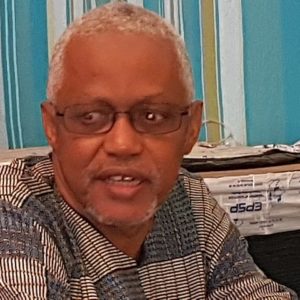
Boubacar BARRY
Expert in charge of Water and Rural Development, 9th World Water Forum

Andrea CARMEN
Executive Director, International Indian Treaty Council

Sonja KOEPPEL
Secretary of the Water Convention, UNECE

Cathy Yitong LI
COP26 Ambassador for the UK & YOUNGO, UNFCCC

Walter PEBE DIAZ
Hydrological Resource Planning Specialist, National Water Authority, Peru

Jerker TAMELANDER
Director, Science and Policy, Ramsar Convention on Wetlands

Claire WARMENBOL
Communications and Partnerships Manager, Global Water Programme, IUCN
Summary
Welcome and Introduction
Setting the Stage of NbS for Water | Claire Warmenbol, IUCN Global Water Programme
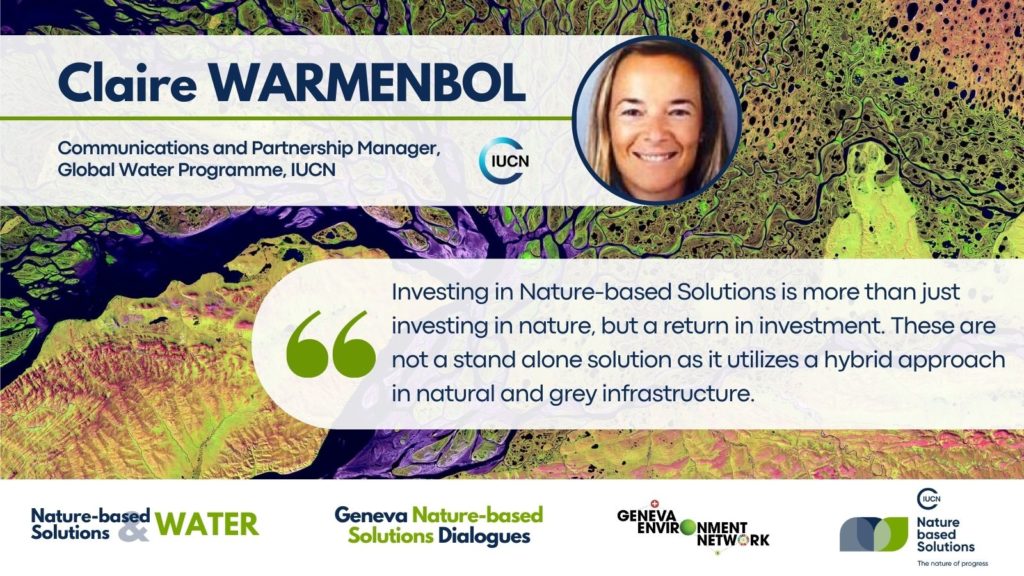
- At the 2016 World Conservation Congress in Hawaii, IUCN members’ adopted Resolution 069 that defined NbS as “actions to protect, sustainably manage and restore natural or modified ecosystems, that address societal challenges (e.g. climate change, food and water security or natural disasters) effectively and adaptively, simultaneously providing human well-being and biodiversity benefits”
- Though more are embracing the NbS approach today, the increased demand and use of NbS has also led to misunderstanding and misuse of the concept. In July 2020, the IUCN Global Standard for NbS was launched as a tool to help implement NbS projects. This was a way to increase clarity and precision as to what NbS encompasses, and how it can be successfully implemented. It also acts as a framework for learning how to improve NbS and sharing this knowledge globally in a structured manner.
- Various water-related ecosystems already perform an environmental service. You could compare this service to an infrastructure function, natural infrastructure that is essentially a service nature provides for free. For example, mangroves protecting shorelines from storms and the impact is lessened, peatlands sequestering large amounts of carbon thus less carbon enters our atmosphere, wetlands filtering contaminated water reducing the need for expensive filtration facilities, lakes storing large water supplies replacing expensive built storage facilities, and floodplains absorbing excess water runoff helping attenuate floods and stormwater. All of these are nature-based solutions that can help mitigate and adapt to climate change.
- We don’t need to look far to understand that climate change and water are closely inter-connected. That water –too much or too little- plays a key role in terms of impact and consequences of climate change, and as such investing in good water management and tapping into the benefits of nature-based solutions are wise business and policy decisions. Creating resilience to climate change can be done through supporting the ecosystem services we rely on.
- Investing in NbS also amplifies and optimises the performance of engineered infrastructure — dams benefit from intact uphill forests which help stabilize soils and hold back erosion upstream, while lakes and wetlands regulate flows and store water, thereby reducing volumes of water that must be stored in built reservoirs and hence cutting the cost of built water storage investments.
- A more concrete example of this is the Sponge City Concept. As part of the GrowGreen project, a project in Wuhan, China back in 2018 had the Chinese adopting NbS approaches through this Sponge City concept through constructing rain gardens, grass swales, artificial ponds and wetlands to help absorb excessive rainfall through soil infiltration and thereby alleviating the burden and cost of engineered infrastructures which traditionally would have been upgrading existing drainage systems.
- In short, Nature-based solutions for water are crucial in our journey to reach all the Sustainable Development Goals (SDGs), not only SDG 6 on clean water and sanitation for all. Water is central to achieving all the goals and should be far better considered in the various international processes for biodiversity, health, disasters, climate change, land management, and agriculture.
- For the first time ever, this COP had a specific Water and Climate Pavilion which was organised by over 30 water organisations. It came about as a result of the Water Pathway of the Marrakesh Partnership for Global Climate Action whereby the water community joined forces to increase impact through collaboration. The knowledge the water pavilion brought to COP was more than needed.
- There was also a Peatlands Pavilion where important discussions took place, such as for example the Partners for Wetlands call for restoring wetlands under the banner of the UN Decade for Wetland Restoration. The Global Wetland Outlook released by the Ramsar Convention on Wetlands in 2018 an alarming trend in wetland loss was revealed in that at least 35% of the world’s natural wetlands have been lost since 1970, and this will have serious implications on our ability to store carbon and support broader climate adaptation. The International Organization Partners of the Ramsar Convention– which are BirdLife, The International Water Management Institute (IWMI), The Wildfowl & Wetlands Trust, Wetlands International, WWF, and IUCN – are supporting a call for Wetland Restoration under the newly UN Decade on Ecosystem Restoration.
- Some major water-related events to look out for: UN Water Decade and the Dushanbe Water Process (co-hosted by Tajikistan and Netherlands in 2022), Ramsar COP14 in Wuhan, China, World Water Forum (Senegal in March 2022), and Stockholm World Water Week (August 2022).
Panel Discussion
Bridging Boundaries : How to Foster Basin-wide Cooperation | Sonja Koeppel, UNECE Water Convention
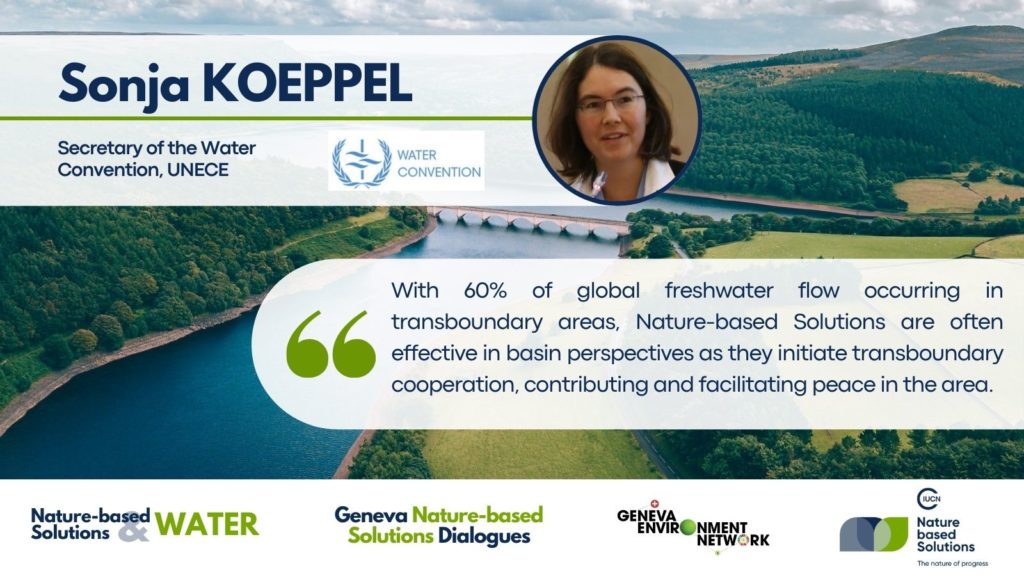
- NbS provide benefits to society, economy, and the environment. However, they also provide benefits for peace. With 60% of global freshwater flow occurs in transboundary basins (rivers, lakes and aquafers). Transboundary cooperation is therefore crucial for sustainable development, peace, ecosystem and climate resilience, and water management.
- NbS are effective from the basin-perspective as they provide opportunities to initiate and strengthen transboundary cooperation in various basins in the world, thus contributing to regional peace and integration in the area.
- There are multiple experiences of this is in Danube in the Rhibe river basin, where heavy works are underway to restore floodplains. The Mekong river basin also works on NbS. Another example is of the Chu and Talas river basin in Kyrgyzstan and Kazakhstan where community floodplain restoration has been fostered. In the Dniester River Basin in Ukraine and the Republic of Moldova, where natural flow regulation measures have been implemented to restore floodplains as well.
- In the framework of the Convention on the Protection and Use of Transboundary Watercourses and International Lakes (Water Convention), it requires its parties to reduce impacts of transboundary activities as well as restore ecosystems. NbS therefore has been among the very first priorities in the Convention. Recently in 2009, a Global Workshop on Ecosystem-Based Adaptation in Transboundary Basins was held with IUCN and other partners.
- Where to go next? We need standards and criteria to measure progress. We need to motivate financial institutions to work and promote such measures. There are some developments in this regard, but much more is needed. We need to build capacity, and here the basin organizations across the world bring together countries for such important activities.
- What are the key elements for NbS in transboundary basins? We need to support proper policy instruments, sufficient funding, increasing knowledge base and capacity, adopt landscape approach and planning, and engaging in transboundary cooperation with multiple stakeholders (from basin organizations, communities, IFIs, and CSOs). I hope many more basins around the world continue to foster such solutions.
Protecting and Harnessing the Power of Wetlands | Jerker Tamelander, Ramsar Convention on Wetlands
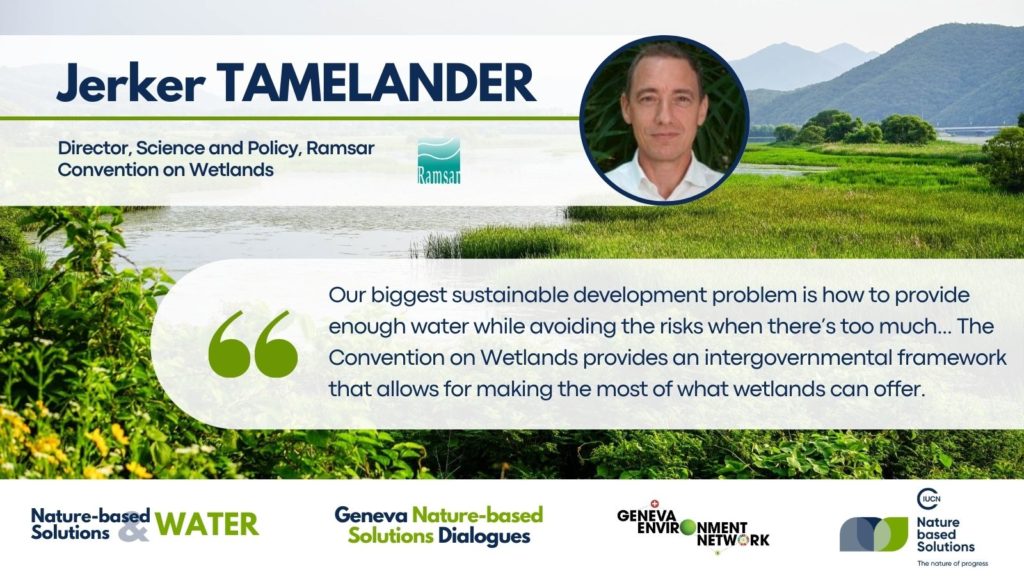
- Aside from being the most important source of life, water is also the source of the greatest challenges we face. 90% of all natural-hazards we face are water-related. By 2025, 2 billion people will not have access to safe drinking water. By mid-century, 2 billion people will be vulnerable to floods, and more than half of the world’s population will be facing water insecurity.
- Our biggest sustainable development challenge is related to how to provide enough good quality water while being able to cope with situations when there’s too much in a short period of time. We can deal with these problems through wetlands.
- Almost all the freshwater we draw comes from wetlands, and they regulate, moderate water cycles, replenish aquifers, etc. Despite this value, they’re also among the most at risk ecosystems. 35% has been lost since 1970, at least 3 times faster than the rate of forest loss. Close to 90% of pre-industrial wetlands coverage has been lost. Freshwater species population have declined by more than 75% in the last 40 years.
- Conversion and loss of wetlands has also been a driver of climate change. The loss of peat has not only been a huge source of greenhouse gas emissions, but a huge loss as well of sources of climate change mitigation.
- We are faced with a wetland protection and restoration imperative. It is a scientific fact. This is an opportunity because wetlands are one of the most cost-effective nature-based solutions there are. This is where the Convention on Wetlands provides an intergovernmental framework that provides opportunities for global collaboration that makes the most of what wetlands can offer in achieving SDGs.
- There are 172 Parties to the Convention, which includes a broad definition of wetland. It provides a mechanism through which actions can be taken across different types of wetlands. There are three corporate missions: first, the designation of wetlands with international importance (Ramsar sites), the wise use of all wetlands, and international cooperation towards sustainable development. While the origin of the Convention 50 years ago was to designate wetlands as a habitat for waterfowl, it was always expressed as a contribution towards sustainable development.
- Close to 2,500 Ramsar sites cover almost 260 million hectares, where some iconic sites show clear examples of how site protection can reach massive benefits. These provide anchor points for broader landscape efforts: from water, climate change mitigation, etc.
- The wise use of all wetlands goes beyond site protection, but into integrated policy frameworks. There is the greatest opportunities to establish better foundations for hybrid solutions where wetlands are integrated with engineering options in addressing various water issues. The Convention has a range of agreed tools and guidance that address all these issues of wetlands management.
- The Convention is also one of the basis of the national wetland inventories that Parties prepare to be able to track and report on the SDG indicator 6.6.1, the extent of water-related ecosystems.
- There is much in place that can be applied and leveraged towards greater wetland-based efforts and solutions. Our Conference of Parties in November in 2022, which is a clear step in the timeline. Prior to this, there is also World Wetlands Day on 2 February, which was a result of a General Assembly resolution earlier this year. We look forward to scaling up attention in society.
- With regards of the opportunity in the policy space of wetland action, wetlands need to be at the forefront of global water, biodiversity, and climate actions and agenda. These need to leverage the frameworks that already exist for this purpose: beyond the Biodiversity Convention and the Climate Change Convention, you also have the Wetlands Convention and the Water Convention that directly speak to the systems that we are dealing with.
- There’s opportunity for this enhanced convergence, as seen in COP26. For the first time, there’s a strong nature footprint within the Glasgow Outcome. The Outcome doesn’t mention the word “water”, but many of the provisions there encompass the ecosystems that provide us water.
- There’s much greater policy convergence than we have seen in the past. There’s much broader recognition across various communities and sectors, where biodiversity and climate are not separated.
- The same issues need to be part and parcel of discussions on the post-2020 Global Biodiversity Framework that will happen here in Geneva, as this provides a super year for delivering outcomes that we hoped for in 2020.
Recognition, Rights, and Climate Finance Access for Resources Management | Andrea Carmen, International Indian Treaty Council
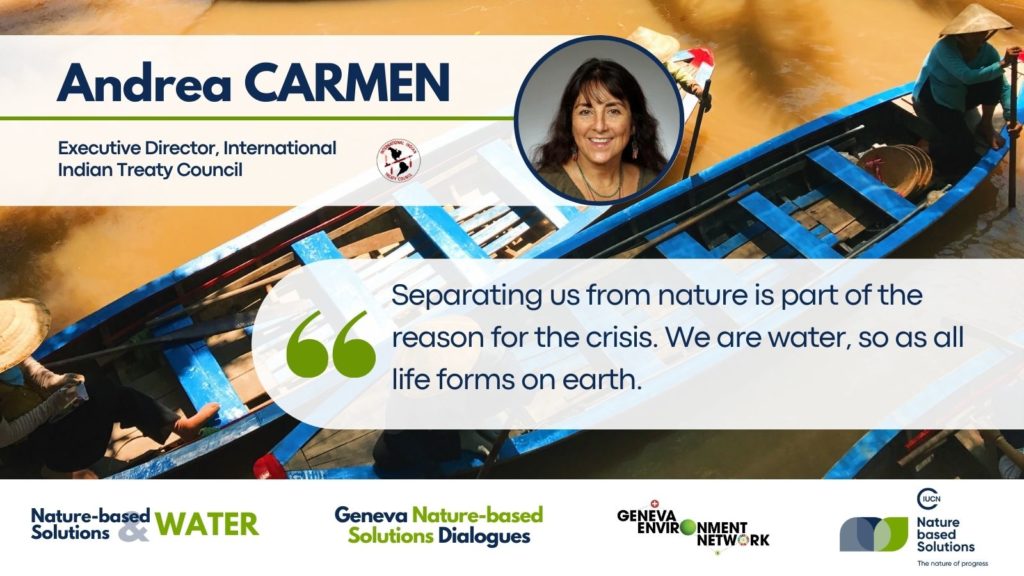
- Lios em chaniavu. Thank you very much. I’m also speaking in my capacity as a representative of Indigenous Peoples of North America on the of the Facilitative Working Group of the UNFCCC constituted body called Local Communities and Indigenous Peoples Platform, that was put in place 3 years ago.
- As a constituted body dealing with knowledge and practices of Indigenous Peoples in relationship to climate change, we have never utilized the concept of and term “Nature-based Solutions” in our discussions and in our workplan approved just recently in Glasgow. We have questions on this. What does this really mean? If there are NbS, what are the non-nature-based solutions?
- Our traditional knowledge holders participated in COP26 have stressed that we, as humans, are part of nature. We already are nature. Separating us from nature, as an actor on nature whether for sustainable or for non-sustainable reasons, is part of the reason for the crisis.
- We are water. Human beings are water, so as all life forms on earth. Our relationship with water is sacred, intergenerational, and cyclical in terms of our way of knowing. We have learned from water, and have responsibility towards it.
- We talk about rights- and culture-based solutions. Based on the UN Declaration on the Rights of Indigenous Peoples which affirms our rights and their cultural heritage, traditional knowledge and expressions. As such, we have some questions on what NbS really means, especially on the misuse of this term, such as carbon trading and offsetting that many Indigenous Peoples do not see as solutions.
- An example of a solution that Indigenous People already use is seen from the relationship high-desert farmers in the Hopi and Yaqui territories have with water, as it is fundamental for their lives. The corn seed from the Hopi territory shown teaches us about adaptation. In a desert area without wetlands, farming is based on rainfall and the amount of water that is stored in the soil. The long root that goes deep.
- Another example is from the Tohoni O’odham Nation in Sonoa Desert, Arizona, where they bring back the traditional method of rainfall storage and irrigation. They use the clay in the desert without any rivers or wetlands. We are beginning to revitalize and continue to practice the traditional methods that were the source of survival, such as being able to predict the weather through insects and the phases of the moon.
- In the traditional system of Hawai’i, from the sky to the ocean there are specific words and uses along those lines for the water systems. This exact area of the watershed now has an airbase, a golf course and a built community. Now, they are working to rebuild and restore these relationships. There are restored traditional taro beds, where natives removed invasive species such as eucalyptus that use a lot of water. Using traditional knowledge, they listen to the water that tells them what goes where. We listen to the water, we learn from the water, and we are the water.
- The intergenerational knowledge sharing and the continuation of our ways of knowing is based on being able to talk to the plants and water and listen to them. We have ceremonies for the water that sustains us. Once again, we are the water. We can’t separate water from ourselves, from our life, and from our responsibilities as human beings. In the face of climate change, our knowledge continues to sustain us. Choque Utesia. Thank you very much.
Water Management Plans : Going Beyond Grey Infrastructures | Walter Pebe Diaz, National Water Authority, Peru
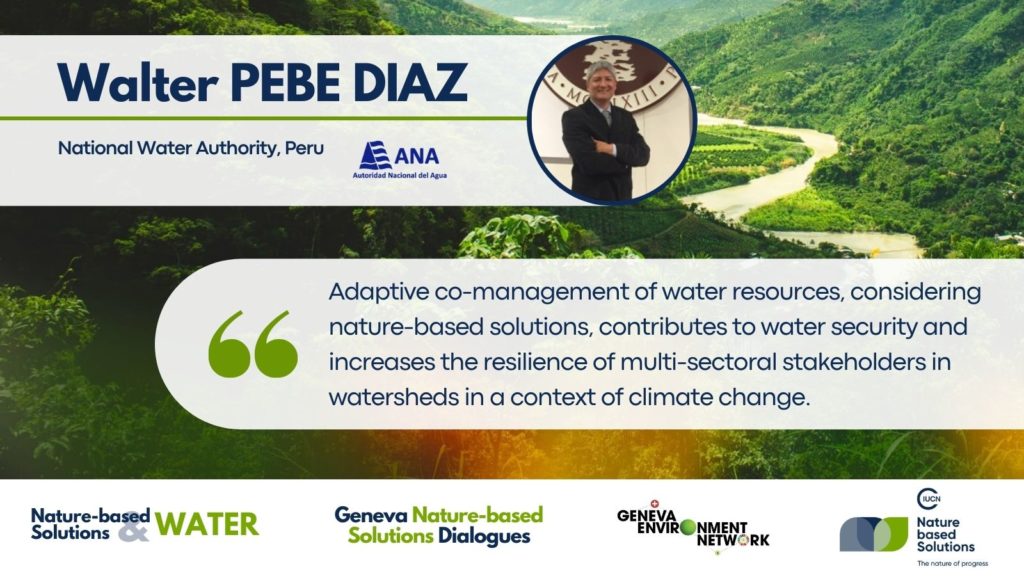
- The historical and cultural heritage of Peru has an ancient culture that preceded the Empire of the Incas. Water Management in the country dates back more than 5,000 years, where the ruling elite then read the behavior of the weather, which allowed them to predict whether the year was going to be good or bad in terms of water availability – a vital resource for domestic use and work in agriculture, fishing and trade.
- The Peruvian climate is determined by its geographical location, the presence of the Andean mountain range, the cold water current (Humboldt current) and the warm water El Niño current.
- In the context of climate change adaptation, megacities such as Lima, Peru is located in a desert ecosystem, with the Rimac River having an average annual flow of 27 m3/s (compared to Cairo, Egypt’s 3,000 m3/s). This represents a huge challenge in providing water security.
- Peru is highly vulnerable to the effects of climate change, to cite one evidence: in the last 50 years we have lost 51% of the coverage of tropical glaciers, which represented water reserves for the dry seasons. As such, the Peruvian government identified water as a priority thematic area to address the effects of climate change as it continues to pose serious problems to water resources management.
- The National Water Authority (ANA) thinks this is the opportunity to strengthen the National Water Resources Management System (SNGRH) and the Basin Water Resources Councils, to implement a new adaptive and resilient water culture to climate change through
the Basin Water Resources Management Plans. Some ways of addressing this in a multisectoral manner are:- Major hydraulic infrastructure,
- Conservation and recovery of natural infrastructure for the provision of water ecosystem services,
- Implementation of monitoring and surveillance of the quality of water resources,
- Implementation of a hydrometric network for water collection and distribution in major and minor hydraulic infrastructure,
- Modernization of the granting of water use rights,
- Promotion of multi-sectoral and multi-stakeholder articulation mechanisms for IWRM for the effects of Climate Change, and
- Implementation of information services for multi-sectoral water resources planning and management.
- Regarding natural infrastructure and nature-based solutions, community-participated interventions in the high Andean watersheds have begun to be carried out in Peru as early as 40 years ago, with the Programme for Watershed Management and Soil Conservation in Peru – PRONAMACHCS created in 1981 (currently called AGRORURAL) is an example. These interventions had the peasant communities as the main actors, which, due to their ethnocultural diversity, maintain traditions of community organization and ancestral knowledge that allow them to manage their water resources and incorporate pressurized irrigation techniques due to the topographical advantages provided by the terrain.
- The main interventions of this project are: reforestation with native species, afforestation, gully control, terraces, terraces, terraces and / or soil conservation practices, infiltration ditches, and water catchment areas, among others. As for ancestral knowledge, we can cite an emblematic one called Amunas or mamanteo, which is to lead the water from a stream in the rainy season and lead it to sectors of the communal territory with geological characteristics that allow infiltration and storage which is then available in lower parts as springs that are used in summer season.
- In the next 5 years, an investment in the order of 250 million dollars will be mobilized in Natural Infrastructure and NbS.
- In conclusion, we can affirm that Peru has a marked geography due to the presence of the Andes Mountains, two main currents of the Pacific Ocean that determines a desert water regime on the Pacific coast and a tropical rainforest on the Amazon slope. The strategic natural infrastructure is located in the upper part of the basins, allowing our country to complement the major water planning with gray infrastructure with nature-based solutions for water consolidation and flood control of our big cities. Adaptive co-management of water resources, considering nature-based solutions, contributes to water security and increases the resilience of multi-sectoral stakeholders in watersheds in a context of climate change.
Global Youth Position on NbS | Cathy Yitong LI, COP26 Ambassador for the UK & YOUNGO, UNFCCC
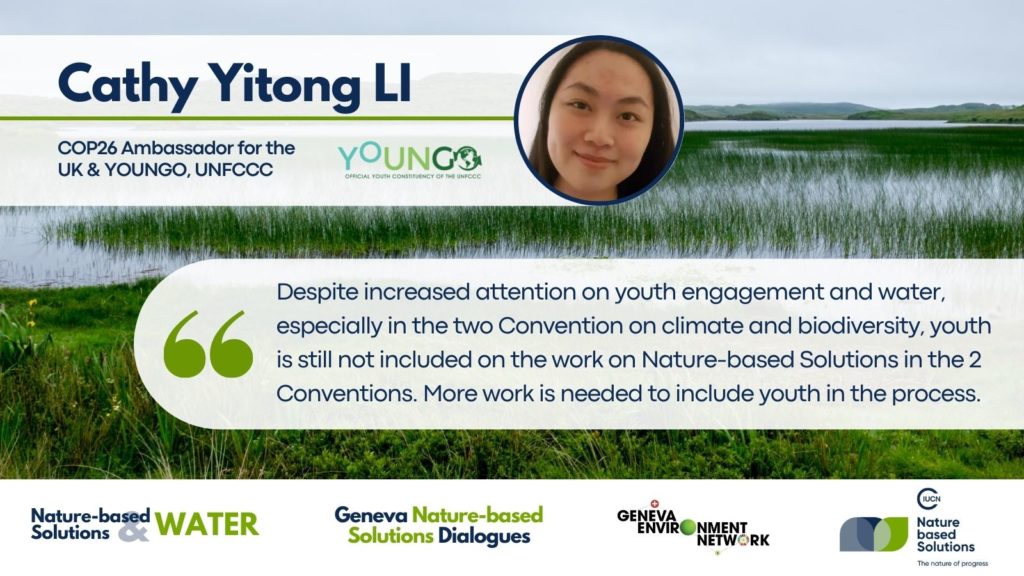
- I am one of the UK ambassadors of COP26, and I also follow UNFCCC processes from the gender and youth perspective. It was indeed an interesting year.
- The Global Youth position on NbS is a collaboration of the Global Youth Biodiversity Network (GBYN), the youth constituency of the CBD, Youth4Nature, and YOUNGO, the youth constituency of UNFCCC.
- The reason behind the project is because the youth position on NbS is missing in the international level, and NbS is such a critical field for the youth as we are a key stakeholder group who will take the consequences in the future.
- In April, at the IUCN Global Youth Summit, we launched our info brief that provides accessible NbS information for the youth. We launched a survey as a global youth consultation. Then, we produced the Global Youth NbS Position Statement released during COP26.
- The survey conducted in 3 languages had 118 countries represented with over 1000+ responses. There was roughly gender equity in respondents, though we, of course, hoped there would be more gender balance in future work. Most respondents are also under 30 years old.
- Statement Summary.
- Majority had a strong to medium understanding of NbS, showing how the youth are interested in the topic. 82% are neutral to very excited about NbS and how they have helped bring nature and climate discussions closer together.
- The rest however are concerned, with issues ranging from greenwashing, monoculture plantations, land grabbing and impacts to Indigenous and human rights, and delayed decarbonization. There was also a concern over the perceived dominant narrative of carbon sequestration and offsetting.
- In terms of key messages, they found that practices are not new, such as the ecosystem approach. NbS is also found to be vulnerable to greenwashing, especially to the youth, Indigenous Peoples, and gender sectors.
- Decarbonization remains to be crucial in our agenda, while biodiversity is not just a side benefit to ensure ecosystem integrity and functions. We hope both Conventions can increase attention on NbS, by having a legally agreed framework, making sure there are legally-binding safeguards in place, while calling out false solutions.
- On COP26 and youth engagement and representation in water, we had made some progress in youth engagement in other fields, such as technology where for the first time, women and youth have a real seat at the table. At the same time, although we have received increased attention by the two Conventions on NbS and Water, the youth is still not included in the work on NbS at all. More work needs to be done for youth to be included in the process.
Next Step in the NbS for Water Agenda : 9th World Water Forum | Boubacar Barry, 9th World Water Forum

- As part of the process leading up to the next World Water Forum, we need to face reality, NbS and water are crucial because water is crucial to all human activities. Preserving water will allow us to have sustainable development.
- What makes the next WWF in Senegal unique? Senegal has been a part of the Global High-Level Panel on Water and Peace at the UN, and based on its performance on hydrodiplomacy and hydropolitics, Senegal has shown leadership in promoting water security.
- As opposed to how previous fora focus on WASH (domestic supply of water, sanitation, and hygiene), this year’s World Water Forum brings in new aspects: water for rural areas and productive water. How can we use water to transform rural areas and change them into sites of economic development?
- The changes are also in the process. Up to now, the approach was thinking in silos, where decision makers and technicians had not interrelations. The Forum is now built on four pillars: Water Security and Sanitation, Water for Rural Development, Cooperation, and Means and Tools.
- The theme this year is Water Security for Peace and Development. The sub-Saharan countries in Africa, who are among the poorest in the globe, have very little water. We need to make use of it and make profit out of it. It’s not just water and sanitation, but to go beyond it, beyond SDG 6, towards food security and other elements for better living.
- How do we proceed? This is the first time when the Forum has been open. We have 23 groups and more than 1,000 people to bring together decision makers, politicians, youth, women, and civil society who have looked at water as a crucial element for well-being. We put together a platform where people can discuss different issues and topics under the main pillars.
- One of the key elements asked was to come with key messages, projects addressing problems ranging from local to global issues. The next thing we have is the 2nd Stakeholder Meeting where we presented the results of the one-year discussions. All these messages put together will be written into the final program held in the 9th World Water Forum.
- The results of the Forum will be taken in by heads of state, and these will be fed into the UN Water Conference in 2023. Listening to the projects presented, I wonder why these projects cannot be part of the Dakar Initiative 2022, where we try to bring in projects all over the world that answer questions? We need a Forum that gives us solutions on how best we can handle the issues we face on water.
Q&A
Q: How can Nature-based Solutions be integrated in addressing water contamination?
Claire Warmenbol: Water pollution is for sure a big issue affecting everyone, from microplastics to chemicals and more. IUCN is pleased to share its knowledge on the issues relating to pollution in waterways.
Q: It has been mentioned that wetlands are the most cost effective NbS; is this both for conserving wetlands that exist or also for constructing new wetlands? Is there some research comparing cost efficacy of various NbS options, including on wetlands?
Jerker Tamelander: Considering how much wetland has been lost, restoration needs significant focus. This was the topic of the events the International Organization Partners of the convention organized at IUCN WCC and at COP26. This has been emphasized in a number of COP resolutions, including the need to restore peat and blue carbon ecosystems for climate outcomes. This is also the topic of some new briefing notes by the Scientific and Technical Review Panel. We also prepared some fact sheets for the launch of the UN Decade on Ecosystem Restoration which include some cases studies. The actual cost is also dependent on context, thus a generic cost for Nature-based Solutions probably does not exist. We need to be honest about the genuine cost of NbS in relation to other solutions. When it comes to adaptation, experience has shown that it is worth investing in NbS for the services they provide even without accounting for any adaptation benefit. In many cases, the investment is so low that we should really protect and safeguard nature whether we call it an NbS or not.
Concluding Remarks
Sonja Koeppel: In more than 77% of transboundary basins around the world, environmental protection is included in the agreements. I would like to encourage all the transboundary basins to prioritize this topic and include NbS in their basin management plans due to the numerous benefits they bring.
Jerker Tamelander: Reaping the benefits of wetland-based solutions at the scale society needs is dependent on investment at scale from public and private resources for a multiple of stakeholders, including local and indigenous community, which are often the best stewards of nature. To build back better, we need to build back wetter.
Andrea Carmen: Our cyclical relationship and interdependence with nature is not new to indigenous people; it’s our way of life. If we are going to rely on water to help us solve problems and to survive, we need to ask the water for permission – free prior informed consent right?. We should ask the water how it can help us solve the crisis that we as humans have put ourselves and our natural world into. Indigenous people do ask for permission and instructions, and it would be good for everyone to think about that as they launch these kinds of programmes.
Walter Pebe Diaz: Adapting to climate change is a vital concern for everyone. In this regard, the theme of natural infrastructure will be central to water management and policy in Peru for the upcoming year. Including local communities and ensuring their full participation in these efforts is essential.
Cathy Li: As mentioned, youth shares some concern about the potential of greenwashing. Thus, we hope to see legally-binding safeguards and the inclusion of civil society and other stakeholders, especially youth, in the conventions and the work on NbS at the national, subnational and local levels.
Boubacar Barry: I invite all the attendees to explore the projects under the Dakar Initiative 2022, which aims to identifies case examples of how we can best use water. Many NbS initatives could be include there. It would also be great to host a special session focusing on NbS at the World Water Forum.
Claire Warmenbol: Water is a connector, not just in nature, but also among people. We can work together beyond our affiliations to ensure more impact and positive outcomes for nature and people. We all are water; we cannot survive without it. We use nature because it is valuable, but we lose nature because it is free. NbS can help us ensure that nature is valued and recognized for the immense services it provides, to us and the future generations.
Video
In addition to the live WebEx and Facebook transmissions, the video is available on this webpage.
Documents
Links
The update on Nature-based Solutions provides relevant information and the most recent resources, news and articles from the various organizations in international Geneva and other institutions around the world.
- World Water Forum
- Geneva Water Hub
- Global Water Programme, IUCN
- Ramsar Convention on Wetlands
- National Water Authority, Peru
- Water Convention, UNECE
- International Indian Treaty Council
- Water & Climate Pavilion at COP26
- Global Youth Position Statement on Nature-based Solutions
- Water and the Environment | Geneva Environment Network (constantly updated)
